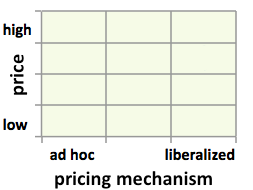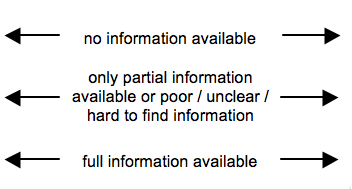Knowledge fuels change - Support energypedia!
For over 10 years, energypedia has been connecting energy experts around the world — helping them share knowledge, learn from each other, and accelerate the global energy transition.
Today, we ask for your support to keep this platform free and accessible to all.
Even a small contribution makes a big difference! If just 10–20% of our 60,000+ monthly visitors donated the equivalent of a cup of coffee — €5 — Energypedia would be fully funded for a whole year.
Is the knowledge you’ve gained through Energypedia this year worth €5 or more?
Your donation keeps the platform running, helps us create new knowledge products, and contributes directly to achieving SDG 7.
Thank you for your support, your donation, big or small, truly matters!
Difference between revisions of "Fuel Prices Indonesia"
***** (***** | *****) |
***** (***** | *****) m |
||
| Line 1: | Line 1: | ||
| + | |||
{{Fuel Price Factsheet | {{Fuel Price Factsheet | ||
|Fuel Price Country=Indonesia | |Fuel Price Country=Indonesia | ||
| Line 16: | Line 17: | ||
|Fuel Price Exchange Rate Date=2010/11/17 | |Fuel Price Exchange Rate Date=2010/11/17 | ||
|Fuel Price Last Updated=2011/05/01 | |Fuel Price Last Updated=2011/05/01 | ||
| − | |Fuel Price Composition Annotation=Transport | + | |Fuel Price Composition Annotation=Transport fuels are highly subsidized in Indonesia, resulting in fuel prices that are among the lowest in Asia. As of February 2011, about 43% of the actual costs of 88 octance gasoline are covered by the government through subsidies (→App. A2) |
A detailed price breakdown is not available online, hints welcome. | A detailed price breakdown is not available online, hints welcome. | ||
| Line 26: | Line 27: | ||
|Fuel Transparency Price Composition=1 | |Fuel Transparency Price Composition=1 | ||
|Fuel Transparency Pricing Mechanism=1 | |Fuel Transparency Pricing Mechanism=1 | ||
| − | }} | + | }} {{Fuel Price Factsheet Source |
| − | {{Fuel Price Factsheet Source | ||
|Fuel Price Factsheet Source Type=Pump prices and margins | |Fuel Price Factsheet Source Type=Pump prices and margins | ||
|Fuel Price Factsheet Source Link=http://www.shell.co.id/home/content/idn/products_services/on_the_road/fuels/our_price/ | |Fuel Price Factsheet Source Link=http://www.shell.co.id/home/content/idn/products_services/on_the_road/fuels/our_price/ | ||
| − | }} | + | }} {{Fuel Price Factsheet Source |
| − | {{Fuel Price Factsheet Source | ||
|Fuel Price Factsheet Source Type=Other Information | |Fuel Price Factsheet Source Type=Other Information | ||
|Fuel Price Factsheet Source Link=http://www.iisd.org/pdf/2010/lessons_indonesia_fossil_fuel_reform.pdf | |Fuel Price Factsheet Source Link=http://www.iisd.org/pdf/2010/lessons_indonesia_fossil_fuel_reform.pdf | ||
|Fuel Price Factsheet Source Annotation=GSI: Lessons learned from Indonesia’s attempts to reform fossil-fuel subsidies | |Fuel Price Factsheet Source Annotation=GSI: Lessons learned from Indonesia’s attempts to reform fossil-fuel subsidies | ||
| − | }} | + | }} {{Fuel Price Factsheet Source |
| − | {{Fuel Price Factsheet Source | ||
|Fuel Price Factsheet Source Type=Other Information | |Fuel Price Factsheet Source Type=Other Information | ||
|Fuel Price Factsheet Source Link=http://www.globalsubsidies.org/files/assets/ffs_gsiunepconf_sess2_askolani.pdf | |Fuel Price Factsheet Source Link=http://www.globalsubsidies.org/files/assets/ffs_gsiunepconf_sess2_askolani.pdf | ||
|Fuel Price Factsheet Source Annotation=Fuel Subsidy Policy in Indonesia | |Fuel Price Factsheet Source Annotation=Fuel Subsidy Policy in Indonesia | ||
| − | }} | + | }} {{Fuel Price Factsheet Source |
| − | {{Fuel Price Factsheet Source | ||
|Fuel Price Factsheet Source Type=Other Information | |Fuel Price Factsheet Source Type=Other Information | ||
|Fuel Price Factsheet Source Link=http://www.pertamina.com/ | |Fuel Price Factsheet Source Link=http://www.pertamina.com/ | ||
|Fuel Price Factsheet Source Annotation=Fuel Subsidy Policy in Indonesia | |Fuel Price Factsheet Source Annotation=Fuel Subsidy Policy in Indonesia | ||
| − | }} | + | }} {{Fuel Price Factsheet Source |
| − | {{Fuel Price Factsheet Source | ||
|Fuel Price Factsheet Source Type=Other Information | |Fuel Price Factsheet Source Type=Other Information | ||
|Fuel Price Factsheet Source Link=http://uk.reuters.com/article/2010/03/12/indonesia-oil-subsidy-idUKSGE62B0CS20100312 | |Fuel Price Factsheet Source Link=http://uk.reuters.com/article/2010/03/12/indonesia-oil-subsidy-idUKSGE62B0CS20100312 | ||
|Fuel Price Factsheet Source Annotation=A1 | |Fuel Price Factsheet Source Annotation=A1 | ||
| − | }} | + | }} {{Fuel Price Factsheet Source |
| − | {{Fuel Price Factsheet Source | ||
|Fuel Price Factsheet Source Type=Other Information | |Fuel Price Factsheet Source Type=Other Information | ||
|Fuel Price Factsheet Source Link=http://www.thejakartaglobe.com/bisindonesia/indonesia-should-delay-fuel-subsidy-limits-minister-says/424765 | |Fuel Price Factsheet Source Link=http://www.thejakartaglobe.com/bisindonesia/indonesia-should-delay-fuel-subsidy-limits-minister-says/424765 | ||
|Fuel Price Factsheet Source Annotation=A2 | |Fuel Price Factsheet Source Annotation=A2 | ||
}} | }} | ||
| + | |||
| + | [[Category:Indonesia]] | ||
Latest revision as of 16:02, 15 July 2014
Part of: GIZ International Fuel Price database
Also see: Indonesia Energy Situation
Fuel Pricing Policies
| Local Currency: | IDR |
| Exchange Rate: | 8849.6
|
| Last Update: | 2011/05/01 |
"Pricing policy: The prices of one grade each of gasoline and diesel, kerosene (for households and small businesses), and LPG are controlled and heavily subsidized. LPG sold in 3-kg cylinders is heavily subsidized at Rp 4,250 (US$0.44)/kg. LPG in 6-kg and 12-kg cylinders is sold at Rp 5,950 (US0.62)/kg and LPG in 50-kg cylinders at Rp 7,455 (US$0.79)/kg. The prices of other grades of gasoline and diesel are market-based, but the national oil company Pertamina, and not government, subsidizes LPG sold in larger cylinders, reportedly costing Pertamina Rp. 3.8 trillion (US$0.43 billion) in 2011. The price of LPG subsidized by government has been frozen for years. After raising fuel prices twice in 2005 and once in 2008, government lowered the prices of gasoline and diesel (but not kerosene) in Dec 2008 and Jan 2009, and has not adjusted prices since. In Mar 2012, the parliament voted to block government’s plan to raise fuel prices and agreed to a price increase only if the price of Indonesian crude averages US$121/bbl over 6 months. Government sets an annual subsidized fuel sales quota and fuel subsidy budget, both of which are typically exceeded. Government revised its subsidized fuel quota in 2011 to 40.49 million kl from the original volume target of 38.59 million kl, but the final figure was 41.8 million kl, 8% higher than the original budget. The quota for 2012 was 40 million kl, but consumption exceeded 45 million kl.
Shifting subsidy from kerosene to LPG: To reduce government’s expenditure on the kerosene subsidy, Pertamina launched a kerosene-to-LPG conversion program in May 2007, in which the coverage of areas where subsidized kerosene is being sold is being diminished to zero over time. The free starter package includes a stove, a 3-kg cylinder, a hose and a regulator. The program targets households and micro-businesses. In July 2012, Pertamina reported that it had distributed 54 million packages and saved Rp. 61.6 trillion (US$6.5 billion) in fuel subsidies since the start of the conversion program. It is not clear if these savings are net of (now much larger) LPG subsidies.
Consequences of subsidies: Annual government expenditures on fuel subsidies soared to US$23 billion in 2012. Siphoning off LPG from small cylinders to transfer it to larger cylinders has been partially blamed for some of the series of LPG cylinder explosions―responsible for at least 22 deaths―in the early stages of kerosene-to-LPG conversion campaign.
Rationing subsidized fuels: Despite a 2006 presidential decree forbidding consumption of subsidized gasoline and diesel by industrial consumers, downstream regulator at the time, BPH Migas, said in Sep 2010 that such consumption was continuing and ordered Pertamina to stop selling―BPH Migas estimated that industries consumed no less than 15% of the subsidized fuel quota. In May 2012, the Indonesian president announced new measures to contain fuel subsidies, including a ban on the purchase of subsidized fuels by state enterprises, government officials, plantation, and mining companies, and electronic tracking of sales of subsidized fuels.
Social protection: In both 2005 and 2008, government carried out a time-bound, large-scale cash transfer program targeting the poor and near-poor to compensate them for fuel price increases. After the sharp price increases in 2005, Rp 100,000 (US$11) a month was paid to 19 million poor and near-poor households starting in Oct 2005 for a total of Rp 600,000 (US$66) in two tranches; the original plan was to pay for a year but the program was suspended after the first six months. The top four expenditure items using the cash transfers were rice, kerosene, debt repayment, and health, in that order. After more moderate but still significant price increases in May 2008, the government again implemented cash transfers of Rp 100,000 a month to 19 million households starting in June 2008, this time for a total of seven months in two tranches. Expenditure patterns by the recipients appeared to be similar to those in 2005–06. Some households switched back to biomass from kerosene for cooking, in part because kerosene was more expensive and also because of kerosene shortages. Against the history in Indonesia of sometimes violent and sweeping opposition to fuel price increases in the past, these cash transfers have been credited for the price increases in 2005 and 2008 meeting with few protests. This relative success notwithstanding, a recent survey of 102 representatives of civil society organizations in Indonesia showed little support for cash transfers. Some argued that the direct cash transfer program was too small to make any meaningful impacts. The respondents also contended that cash transfer programs were vulnerable to corruption. A study by Satriana (2009) found that most recipients spent all the cash within a week of receipt, and, although the sample size was very small, large informal levies, the highest of which was Rp 200,000, had been extracted at the village level from a sizable fraction of the surveyed recipients."
(Source: Kojima, Masami. (2013, forthcoming). “Petroleum product pricing and complementary policies:Experience of 65 developing countries since 2009.” Washington DC: World Bank.)
Fuel Prices and Trends
| Gasoline 95 Octane | Diesel | |
|---|---|---|
| in USD* |
|
|
| in Local Currency |
|
|
* benchmark lines: green=US price; grey=price in Spain; red=price of Crude Oil
Fuel Price Composition
Price composition.
Transport fuels are highly subsidized in Indonesia, resulting in fuel prices that are among the lowest in Asia. As of February 2011, about 43% of the actual costs of 88 octance gasoline are covered by the government through subsidies (→App. A2)
A detailed price breakdown is not available online, hints welcome.
At a Glance
| Regulation-Price-Matrix |
| ||||
 |

|

|

| ||
Subsidized fuel is on price level "low" with a price mechanism between "ad hoc" and "liberalized"
No official information found yet; hints welcome!
Sources to the Public
| Type of Information | Web-Link / Source |
|---|---|
| Other Information | http://www.pertamina.com/ (Fuel Subsidy Policy in Indonesia) |
| Other Information | http://uk.reuters.com/article/2010/03/12/indonesia-oil-subsidy-idUKSGE62B0CS20100312 (A1) |
| Other Information | http://www.thejakartaglobe.com/bisindonesia/indonesia-should-delay-fuel-subsidy-limits-minister-says/424765 (A2) |
| Other Information | http://www.iisd.org/pdf/2010/lessons_indonesia_fossil_fuel_reform.pdf (GSI: Lessons learned from Indonesia’s attempts to reform fossil-fuel subsidies) |
| Other Information | http://www.globalsubsidies.org/files/assets/ffs_gsiunepconf_sess2_askolani.pdf (Fuel Subsidy Policy in Indonesia) |
| Pump prices and margins | http://www.shell.co.id/home/content/idn/products_services/on_the_road/fuels/our_price/ |
Contact
Please find more information on GIZ International Fuel Price Database and http://www.giz.de/fuelprices
The following coordinate was not recognized: {{#geocode: Indonesia|google }}.



















